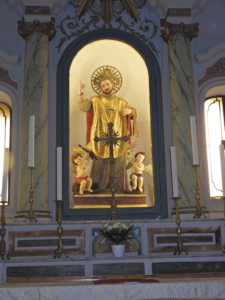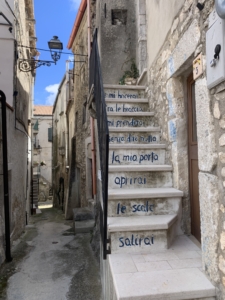Choose an itinerary that blends spirituality, history, and tradition.
Embark on an authentic experience that will lead you to discover sanctuaries, churches, and places of worship steeped in history, nestled in evocative landscapes and charming villages. This journey reveals the deep connection between faith and cultural identity, through monuments, ancient legends, and unique artistic heritage.
Let yourself be guided on a journey that nourishes the soul and enriches the mind, through sacred art, architecture, and centuries-old traditions.
“…our guides will lead your gaze toward that one detail that will remain etched in your memory.”
The Villages of the Gargano
Peschici
We organize for you:
- Individual and group excursions
- Guided tours in Italian and foreign languages
- Packages including multiple services
- Exclusive private services
Discover the itinerary
(click here)
The old heart of the fishing village truly resembles a little nativity scene, with paved narrow streets, small squares, and steps leading down to the sea. Its low houses, whitewashed with lime and topped with gray domes, give it a unique atmosphere with an Oriental flavor. Perched atop a cliff, the village was founded in 970 by Slavic soldiers sent here to face the threat of Saracen pirates.
In the historic center, you’ll find the Mother Church, dedicated to St. Elijah the Prophet, the town’s patron saint, and the medieval castle enclosed within the baronial walls.
Moreover, you will be in one of the few places in the world where you can admire both the sunrise and sunset over the sea.
Vieste
Tailor-made experiences just for you:
- Private and group excursions
- Expert guides in Italian and other languages
- Custom packages with multiple services included
- Exclusive, private services for a truly personal touch
Discover the itinerary
(click here)
The main tourist center of the Gargano, its ancient core stretches over the sea atop a rocky promontory, enchanting tourists and visitors with its timeless charm.
An ancient city of the Daunians, Vieste later became a Greek colony and a Roman municipium. Its strategic position by the sea determined its importance but also made it vulnerable, as the town was frequently attacked by Turks and Saracen pirates.
Monuments to visit include: the castle, the Cathedral built in the 11th century, “Chianca Amara,” and the Pizzomunno.
San Giovanni Rotondo
We organize for you:
- Individual and group excursions
- Guided tours in Italian and foreign languages
- Packages including multiple services
- Exclusive private services
Discover the itinerary
(click here)
It is inextricably linked to the figure of Padre Pio of Pietrelcina, a miracle-working friar with an unparalleled personality, who was canonized in 2002.
The friar’s tomb, bearing the stigmata, his cell, and places dear to him attract visitors from all over the world. To accommodate the millions of devotees who come here each year to pray at the saint’s tomb, the large Church of St. Pio was built, designed by Renzo Piano and inaugurated in 2004.
Another place strongly connected to Padre Pio is the “Casa Sollievo della Sofferenza,” a large and modern hospital established at the end of the 1950s.
Monte Sant’Angelo
We organize for you:
- Individual and group excursions
- Guided tours in Italian and other languages
- Packages including multiple services
- Exclusive private services
Discover the itinerary
(click here)
Tradition tells that around the end of the 5th century, here—inside one of the many natural caves scattered across the area—St. Michael the Archangel appeared. This event marked the fate of the place, which, already during the Lombard period, became an important stop on the Sacred Michael Path, the medieval pilgrimage route that led the faithful from Mont Saint Michel to the Holy Land.
The sanctuary is considered the oldest Michaelic place of worship in the entire Western world and was declared a UNESCO World Heritage Site in 2011.
Vico Del Gargano
We organize for you:
- Individual and group excursions
- Guided tours in Italian and foreign languages
- Packages including multiple services
- Exclusive private services
Scopri l’itinerario
(clicca qui)
It is located just a few kilometers from the coast, on a hill, in a landscape shaped by citrus groves and the lush greenery of the Umbra Forest.
 The historic center, which has preserved its medieval layout intact, is divided into three districts—the “Civita,” “Casale,” and “Terra” quarters—with a labyrinth of steps and narrow streets. You can also find several noble palaces from the 18th century and numerous churches. An ancient underground olive mill houses the Municipal Museum “Trappeto Maratea,” which showcases the traditional phases of olive processing and oil production. Among the typical local products are oranges and lemons, which have been awarded the Protected Geographical Indication (PGI) mark. St. Valentine is not only the saint of love but also the protector of citrus fruits.
The historic center, which has preserved its medieval layout intact, is divided into three districts—the “Civita,” “Casale,” and “Terra” quarters—with a labyrinth of steps and narrow streets. You can also find several noble palaces from the 18th century and numerous churches. An ancient underground olive mill houses the Municipal Museum “Trappeto Maratea,” which showcases the traditional phases of olive processing and oil production. Among the typical local products are oranges and lemons, which have been awarded the Protected Geographical Indication (PGI) mark. St. Valentine is not only the saint of love but also the protector of citrus fruits.

Manfredonia and Siponto
We organize for you:
- Individual and group excursions
- Guided tours in Italian and foreign languages
- Packages including multiple services
- Exclusive private services
Discover the itinerary
(click here)
Situated at the foot of the Gargano and at the end of the wide gulf, the city was named after King Manfred, who founded it in 1256. In the historic center stands the Cathedral, built in 1680 after the previous Gothic cathedral was destroyed by the Turks.
Also notable is the Castle, a fine example of military architecture founded by Manfred himself, which today houses the National Archaeological Museum of the Gargano.
Just outside the city lies Siponto, the oldest diocese in the Gargano and an important maritime port in northern Apulia. The archaeological site, the Sanctuary of Santa Maria Maggiore, and the early Christian basilica are of great historical value.
In 2016, Milanese artist Edoardo Tresoldi created a delicate, permanent metal structure as a reconstruction of the ancient early Christian basilica.
Rodi G.co
We organize for you:
- Individual and group excursions
- Guided tours in Italian and foreign languages
- Packages including multiple services
- Exclusive private services
Discover the itinerary
(click here)
Pittoresco borgo marinaro situato sul litorale nord del Gargano. Il suo nome deriverebbe dall’isola greca di Rodi con cui avrebbe avuto antichi legami commerciali.
Il piccolo centro è famoso per la produzione degli agrumi, una tradizione che risale al Medioevo e che ha reso la cittadina un punto di riferimento per la coltivazione delle rinomate arance del Gargano IGP.
Il suo centro storico è un labirinto di stretti vicoli e scalinate che conducono a piazzette panoramiche da cui si possono ammirare splendide vedute sul mare.
Nel centro dell’abitato il Santuario della Madonna della Libera, luogo di culto in cui si venera il quadro della Madonna assegnato alla scuola gotico-veneziana e risalente al 1400 – 1450
Ischitella
We organize for you:
- Individual and group excursions
- Guided tours in Italian and foreign languages
- Packages including multiple services
- Exclusive private services
Discover the itinerary
(click here)
Ischitella is a small village situated on a hill at 315 meters above sea level. Its elevated position offers breathtaking views, earning it the nickname “the balcony of the Gargano.” The historic center of Ischitella is a characteristic medieval village. Architecturally, the old part of the town is divided into two districts: the medieval “Sottana” and the more recent “Ponte,” dating back to the second half of the 18th century.
The most fascinating and distinctive area remains the “Sottana,” with its terrace houses, external staircases, narrow alleys nestled against the ancient city walls.
The historic center was once surrounded by defensive walls with three gates:
-
The “Portella” (Eastern Gate of Ischitella), still existing, which features a statue of Saint Michael in a niche above it.
-
The “Porta di Levante,” demolished in 1845.
-
The “Porta Grande,” also destroyed.
The walls to the north and south were reinforced by square and circular towers; the southern side had no towers.
Il Rivellino (Below the Walls)
The town was further protected by a second section of walls that started from the baronial palace and connected to the “Rivellino.”
Palazzo Ventrella (Former Castle – Palazzo Pinto), 12th Century
The castle, originally located in what is now the central part of the town, was partly destroyed by the 1646 earthquake and transformed into an 18th-century palace by Prince Francesco Pinto, designed by the famous Neapolitan architect Vanvitelli.
Church of Sant’Eustachio, 18th Century (Giuseppe Garibaldi Square)
The Church of Sant’Eustachio was built by the Pinto family, feudal lords of Ischitella, in 1714.
Other notable churches include the Church of the Purgatory and the Church of San Francesco, famous for its legendary tree.
The Secrets of the Lagoon
We organize for you:
- Individual and group excursions
- Guided tours in Italian and other languages
- Packages including multiple services
- Exclusive private services
Discover the itinerary
(click here)
This itinerary winds through ancient coastal towers, wetlands, springs, and breathtaking panoramic views overlooking the Varano Lagoon.
Crossing the fishermen’s village, we will glimpse the oldest Coastal Towers in the entire Gargano, dating back to the 13th century. We will pass through what was once a marshy area; today the land has been reclaimed but remains below sea level. Here, you can admire various bird species such as cormorants, herons, and egrets.
Majestic centuries-old olive trees will accompany us to the charming Church of the Annunciation, located right on the shores of the lagoon. Our day will conclude with a tasting of typical Apulian products.













